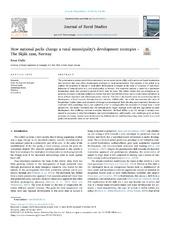How national parks change a rural municipality's development strategies - The Skjåk case, Norway
Peer reviewed, Journal article
Published version

Åpne
Permanent lenke
https://hdl.handle.net/1956/23258Utgivelsesdato
2019Metadata
Vis full innførselSamlinger
- Department of Geography [630]
Originalversjon
https://doi.org/10.1016/j.jrurstud.2019.10.001Sammendrag
The governance structure on which contemporary nature conservation policy and practice are based represents a new structure that may affect development strategies in rural municipalities. The purpose of the article is to analyse the dynamics of change in local place development strategies in the wake of proposals of and establishments of national parks in a rural municipality in Norway. The empirical analysis is based on a qualitative longitudinal study that spanned a period of more than 20 years. The author claims that neo-endogenous approaches represent a valuable addition to studies that have treated state-driven nature conservation initiatives in terms of local resistance and unbalanced power relations. This due to the article's focus on co-evolution and the development of local capacity through external relations. Additionally, the article demonstrates the value of longitudinal studies when rural dynamics of change are investigated. Both planning and complexity theories are combined with assemblage theory are applied in order to conceptualize the dynamics of change from a local perspective. The author concludes that the national parks trigger strategic shifts and new approaches to place development that challenge previous strategies. Moreover, the local ability to act for change is strongly connected to processes of deterritorialization and reterritorialization. Additionally, new challenges grow in these processes of change, namely tensions between the defined and the undefined becoming when results in terms of goals and purposeful ends are not achieved.
